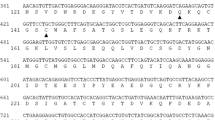Abstract
We report here a cDNA and its deduced amino acid sequence encoding a cathepsin D-like, aspartic protease from Chlamys farreri (denoted as CfCD) by expressed sequence tag and rapid amplification of cDNA ends techniques. The cDNA of CfCD consisted of 1,810 nucleotides with a canonical polyadenylation signal sequence AATAAA and a polyA tail, encoding a short signal peptide of 18 amino acids, a pro-enzyme peptide of 29 amino acid residues, and a mature enzyme of 349 residues. The deduced amino acid sequence of CfCD was significant homology to CDs from human, fish and invertebrates. Two conserved catalytic motifs (VFDTGSSNLWV and AIADTGTSLLVG) and two potential N-glycosylation sites were also identified in the deduced amino acid sequence of CfCD. All this characteristics indicated CfCD should be a member of CDs family. The mRNA spatial expression of CfCD in mantle, gonad, gill, hemocytes, hepatopancreas and adductor muscle was examined by quantitative real-time PCR. mRNA transcripts of CfCD could be detected in all tissues with the highest expression level in hepatopancreas. After 8 h Vibrio anguillarum challenge, the expression level of CfCD changed significantly in all examined tissues except mantle (P = 0.183) and hemocytes (P = 0.069). The information generated in the present study would be helpful for future studies aiming at investigating the detailed functions of cathepsin D from marine invertebrates.








Similar content being viewed by others
References
Benes P, Vetvicka V, Fusek M (2008) Cathepsin D—many functions of one aspartic protease. Crit Rev Oncol Hematol 68:12–28. doi:10.1016/j.critrevonc.2008.02.008
Mommsen TP (2004) Salmon spawning migration and muscle protein metabolism: the August Krogh principle at work. Comp Biochem Physiol B 139:383–400. doi:10.1016/j.cbpc.2004.09.018
Nielsen LB, Nielsen HH (2001) Purification and characterization of cathepsin D from herring muscle (Clupea harengus). Comp Biochem Physiol B 128:351–363. doi:10.1016/S1096-4959(00)00332-8
Wang PA, Stenvik J, Larsen R, Mæhre H, Olsen RL (2007) Cathepsin D from Atlantic cod (Gadus morhua L.) liver. Isolation and comparative studies. Comp Biochem Physiol B 147:504–511. doi:10.1016/j.cbpb.2007.03.004
Dean RT (1975) Direct evidence of importance of lysosomes in degradation of intracellular proteins. Nature 257:414–416. doi:10.1038/257414a0
Baricos WH, Zhou YW, Fuerst RS, Barrett AJ, Shah SV (1987) The role of aspartic and cysteine proteinases in albumin degradation by rat-kidney cortical lysosomes. Arch Biochem Biophys 256:687–691. doi:10.1016/0003-9861(87)90625-4
Barrett AJ (1977) Cathepsin D and other carboxyl proteinases. In: Barrett AJ, Dingle JT (eds) Proteinases in mammalian cells and tissues. The University of Chicago Press, Chicago, pp 209–248
Baldocchi RA, Tan L, King DS, Nicoll CS (1993) Mass spectrometric analysis of the fragments produced by cleavage and reduction of rat prolactin: evidence that the cleaving enzyme is cathepsin D. Endocrinology 133:935–938. doi:10.1210/en.133.2.935
Sevlever D, Jiang P, Yen SH (2008) Cathepsin D is the main lysosomal enzyme involved in the degradation of alpha-synuclein and generation of its carboxy-terminally truncated species. Biochemistry 47:9678–9687. doi:10.1021/bi800699v
Cho JH, Park IY, Kim HS, Lee WT, Kim MS, Kim SC (2002) Cathepsin D produces antimicrobial peptide parasin I from histone H2A in the skin mucosa of fish. FASEB J 368:611–620
Li C, Song L, Zhao J, Zhu L, Zou H, Zhang H (2007) The preliminary study on a potential antibacterial peptide derived from histone H2A in hemocytes of scallop Chlamys farreri. Fish Shellfish Immunol 22:663–672. doi:10.1016/j.fsi.2006.08.013
Li C, Zhao J, Song L, Mu C, Zhang H, Gai Y, Qiu L, Yu Y, Ni D, Xing K (2008) Molecular cloning, Genomic organization and functional analysis of an anti-lipopolysaccharide factor from Chinese mitten crab Eriocheir sinensis. Dev Comp Immunol 32:784–794. doi:10.1016/j.dci.2008.06.013
Duston TR (1983) Relationship of pH and temperature to disruption of specific muscle proteins and activity of lysosomal proteases. J Food Biochem 7:223–245. doi:10.1111/j.1745-4514.1983.tb00800.x
Jia A, Zhang XH (2008) Molecular cloning, characterization and expression analysis of cathepsin D gene from turbot Scophthalmus maximus. Fish Shellfish Immunol doi:10.1016/j.fsi.2008.09.011
Zhang F, Zhang Y, Chen Y, Zhu R, Dong C, Li Y, Zhang Q, Gui J (2008) Expressional induction of paralichthys olivaceus catheosin B gene in response to virus, poly I:C and lipopolysaccharide. Fish Shellfish Immunol 25:542–549. doi:10.1016/j.fsi.2008.07.018
Acknowledgments
We thank the editor and reviewers for their valuable comments on earlier versions of our manuscript. This research was supported by Chinese Academy of Sciences Innovation Program (AK0911DB-097-3) and Open Grant from Key Laboratory of Applied Marine Biology to Dr. Li.
Author information
Authors and Affiliations
Corresponding authors
Rights and permissions
About this article
Cite this article
Li, C., Zhang, H., Li, L. et al. Identification of a cathepsin D potentially involved in H2A cleavage from scallop Chlamys farreri . Mol Biol Rep 37, 1451–1460 (2010). https://doi.org/10.1007/s11033-009-9534-2
Received:
Accepted:
Published:
Issue Date:
DOI: https://doi.org/10.1007/s11033-009-9534-2




